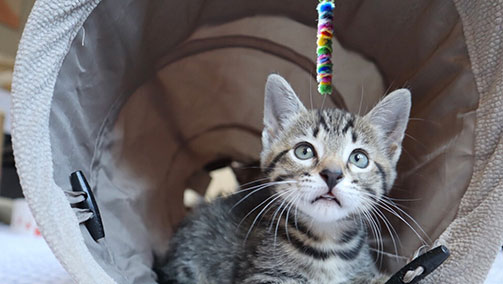Helping Your New Cat Adjust
Helping Your New Cat Adjust To Their New Home
Congratulations on adopting your new cat! Adjusting to a new home can be a frightening experience for a cat. Your patience and understanding during this initial adjustment period can do a lot to help your new cat feel at home.
Preparing for Your New Cat
Regardless of whether or not you have any other pets in the house, you should start off your new cat in a “safe room.” Cats feel comfort in smaller, more confined spaces. Your new cat will acclimate better if started in a single room instead of being given access to the whole house right away.
Importance of Small Room: A small room will give your new cat a chance to get used to the smells and sounds of your home without being overwhelmed. It will give you a chance to make sure your new cat is eating, drinking, and using the litter box properly. It is especially important for shy cats, who may simply hide if allowed to be loose immediately, and if you have other animals in the house.
Picking a Room: To make the transition to your household as comfortable as possible, select a quiet and closed-in area. The “safe room” should have a secure door. Ideally you want to choose a room that does not offer a lot of hiding places. The room that you choose should be a place where family members can easily interact with the cat. We recommend using a bathroom, bedroom, or other small room.
Setting up the Room: You should set up the “safe room” before bringing your new cat home. The room should have food, water, litter box, scratching post and toys.
Kitten-Proof the Room: If you will be bringing home a new kitten, check the room carefully for small objects that can be ingested, heavy things than can be knocked or pulled down, cords that can be chewed on, spaces that kittens can get into but may not be able to get out of easily, etc. Kittens can get into lots of trouble, so look around and make sure everything is safe for them!
The Ride Home
The first thing you should know is that most cats hate to travel. Your cat or kitten should be confined to a sturdy carrier during the ride home as well as during subsequent trips to the veterinarian. Never let your new cat loose in a moving car! He might panic and cause an accident, or get out when you open the car door. Do not leave the cat unattended in the car or stop to visit friends, shop, etc. He may yowl and cry and try mightily to get out of the carrier, but don’t give in. Keep your cat in his carrier until you are safely inside your home.
Once New Cat is Home
When you bring your new cat home, leave him in the carrier until you get to the room where he will be staying. Once in the room, open the carrier door and let him come out at his own pace.
Have the litter box ready when you remove the cat from the carrier. Show him the location of the litter box.
Your cat may be bewildered, fearful or curious. Do not overwhelm him with attention or demands. Remember to keep doors and windows closed.
It is not unusual for cats to leap on top of very high furniture in order to explore or to feel secure. Do not panic, shout, or run to the cat. When he is ready, he will come down alone.
Try to spend several hours with your new cat as he becomes accustomed to your home, but do not overwhelm him with attention or demands if he doesn’t seem ready for it. Let your kitty set the pace.
Your sensitive handling of the initial transition can set the stage for happy settling-in.
Supervise children and teach them to always be gentle with the cat.
If he’s hiding under the bed, don’t force him to come out. If necessary, sit on the floor to talk to him and offer treats. Let him sniff all your belongings and investigate all the hiding places.
Leaving Safe Room: Once your new furry friend seems comfortable with family members, you can start introducing him to the rest of the house or apartment. In general, your cat should stay in his “safe room” for at least the first week. When the cat seems ready to venture out of his room, let him explore at his own pace. Do not rush the cat into exploring the full house; give the cat as much time as is needed.
He will probably walk around carefully smelling every nook and cranny. Kitty should continue to stay in his room when you are not home until you are comfortable that he feels at home outside of his “safe room”—usually a second week will suffice, but some cats may take longer.
Once your new pet gets free roam of the house, you will most likely want to move the litter box to its permanent location. Any time you move the litter box, you should put the cat in the box (at the new location) and let him explore from that reference. Make sure he always has access to “his” room so he can retreat to it if he feels nervous. It will take a little while, but he’ll eventually start to feel comfortable at home.
Remember: It can be hard to resist wanting to pat or play with your new cat right away, but remember that even though you are the best new home your cat could hope for, change is always stressful for cats, so your best bet is to give kitty a chance to settle in for a few hours or even overnight before spending a lot of time interacting. Consider something like Rescue Remedy (by Bach Flower Essences) in the cat’s water, or a plug-in feline pheromone diffuser like Feliway to help keep everyone calm!
Your new cat may be full of self-confidence and itching to get out and make himself at home. Or he may be more of a shrinking violet who needs more time to adjust.
Keep In Mind
- The kitten or cat has had to cope with the transition to a shelter and now he must adjust again to totally new surroundings.
- Allow your cat several weeks to adapt. He needs to get used to you as the provider of love, shelter and food.
- Be sure that all windows and doors are kept closed and that all screens are secure. A scared cat can easily get out of an open window.
- It’s not uncommon for cats to display behavior problems during the first days in a new home, but these usually disappear over time. New cats and kittens often bolt under furniture. Some may spend hours or even days hiding. Sit and talk quietly to the cat. If you must take the cat out of his hiding place, carry him gently to a quiet protected area where he will feel secure. Be sure food, water and litter box are nearby.
- Most cats choose several favorite sleeping spots where they can be comfortable, warm, and free from drafts. Providing a bed for your cat may discourage him from sleeping on furniture. A cozy box or basket lined with soft, washable bedding and placed in a quiet corner makes a suitable cat bed. Some cats enjoy continually picking new sleeping spots. If you allow your cat to sleep on furniture, a washable cover can be placed over favorite spots. A cat’s sleeping spot should be respected as his own. Don’t allow children to disturb your cat when he is resting. Cats need solitude and quiet time.
- Remember, everything is very new and could be scary for your cat—new sounds and smells, separation from the familiar, etc.
- Never introduce your new cat or kitten and existing animals right away!
Some cats will acclimate to a new home faster than others. Following the steps listed above, will ensure a smoother transition for any cat. Best to be safe and go slow than to rush things and have a “scaredy” cat on your hands (or under the sofa).
Please contact us with any questions you have about introducing your new cat to your home.
Additional resources:


